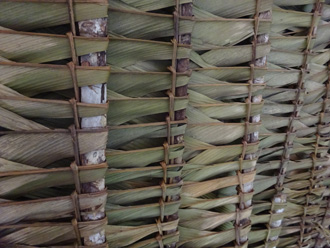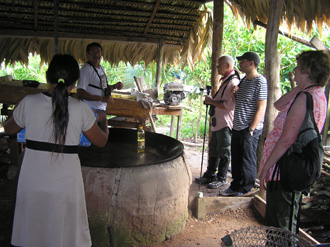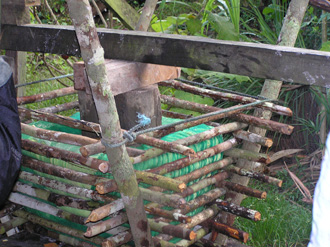Visiting settlers
A Day in the life | Settlers | Hermit | Tapioca/Cassava | Meeting of Waters | Lists | Manaus | M/Y Tucano | Ecology | Maps
Somewhat to our initial disappointment, Edi and Souza were very clear we would be visiting “settlers, not indigenous people.” While it would have been infinitely more interesting to meet the latter, I was actually much more comfortable with the idea of mixing with the settlers. It is one thing for David Attenborough or somesuch naturalist/scientist to be granted special permission to visit a tribal village, it is quite another for a bunch of tourists to invade their village every week. In Tanzania we visited a Maasai village and it was embarrassing, extremely uncomfortable, and worst of all, clearly impacting their way of life. The huge open “market” in the center of the village, where they haggled like crazy to beat you down to a price that was still ten times more than you would pay for the same thing on the sidewalks of Manhatten told us everything we needed to know. The only remotely pleasurable part was it being okay to openly take their portraits. The aggressive life-style of Brazil’s indigenous Indians, learned from Mark’s remarks about one of the reasons large tracts of forest are still intact is “because loggers tend to go in but do not come out again” and Redmond O'Hanlon's great account of the Yanomamö suggested a somewhat different welcome, and one that frankly I applaud.
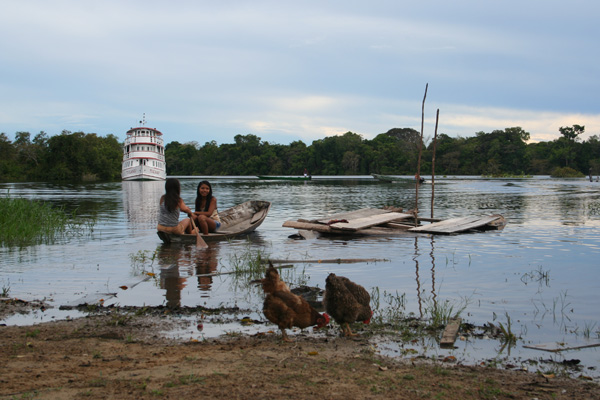 So yes, we’ll settle for the settlers, thanks very much. They are, after all, part of the environment along the Rio Negro, and they provided us a sort of half-way insight into how folks can make a life in the forest, and how the Brazilian government is working to balance the needs of its very different populations. And before we criticize them, especially we Americans should pause to consider the historical record of the US government in balancing the needs of the indigenous Indians of North America.
So yes, we’ll settle for the settlers, thanks very much. They are, after all, part of the environment along the Rio Negro, and they provided us a sort of half-way insight into how folks can make a life in the forest, and how the Brazilian government is working to balance the needs of its very different populations. And before we criticize them, especially we Americans should pause to consider the historical record of the US government in balancing the needs of the indigenous Indians of North America.
Settlers are subsistence farmers originally or directly returning from the city. One great thing about that is that I didn’t need to worry about giving these folks the idea that there was a “better” world out there. What I call the “Walmart invasion”—if the reason we are reaching out to the poorer parts of the world is so that in twenty years we can build a Walmart for them to shop in, then I’m dead-set against helping them. But these folks had already seen that future, and were actively rejecting it. To a point. They were all wearing “westernized” clothes: shorts, t-shirts with English language slogans all over them, and flip-flops of course. Their boats and canoes mostly had outboard motors, and the manioc was shredded with a motorized mill (replacing the girls with their long poles pounding it all day outside their huts in Ghana). Kerosene was readily available even more than 100 miles from anywhere close to big enough to maintain a gas pump. We noticed that one source for gas was the Tucano—we picked up an empty can on our way back from a jungle walk one day, and brought it back full when we visited the village a couple of days later.
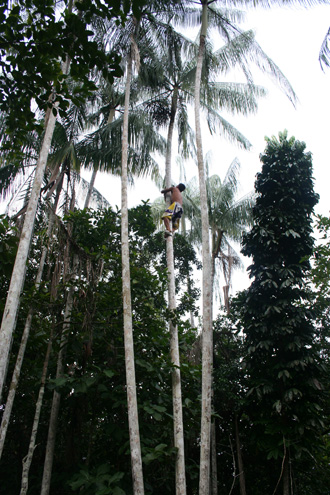
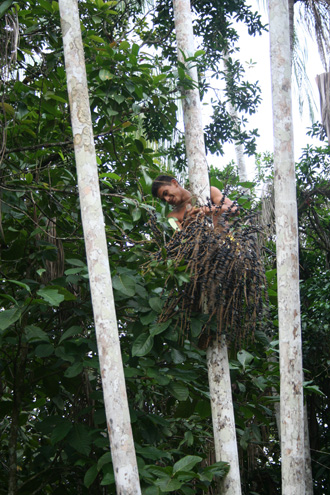
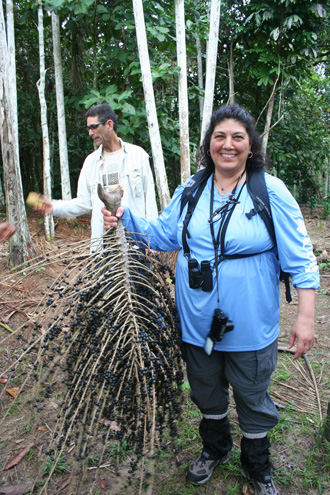
The young settler in this sequence is demonstrating tree climbing using a loop of cloth wrapped around the tree trunk. By inserting his feet into the loop and twisting his ankles out to create enough tension to stand straight, relaxing to slide the apparatus up, tightening and straightening again, he made short shrift of the journey to the top. The goal of the exercise was to harvest a panicle of açaí berries, which Domenica picked up to see how heavy it was, and to pose the panicle for its closeup. The village houses were made of planking that had been created on the spot with a chain-saw, an art that implied some serious skill. And when they move, which they need to do every dozen years or so, they just leave everything, and build again on the new patch of ground. |
Rathole: Açaí, Greenpeace, and Bloomberg As you can see, the açaí berry is similar in appearance to a grape, and produced in branched panicles of 500 to 900 fruits. The fruit can be a major component of native (and settler) diet, but a 2005 article published by Greenpeace International stated that “the tasty dark violet wine of açaí is the most important non-wood forest product in terms of money from the river delta of the Amazon” and Edi definitely emphasized its importance as a cash crop for the settlers. In May 2009, Bloomberg reported that the expanding popularity of açaí in the United States was "depriving Brazilian jungle dwellers of a protein-rich nutrient they’ve relied on for generations. Best of show for me was the "tasty dark violet wine of açaí" that was masquerading as chocolate sauce in the Hotel Tropical's buffet. It wasn't so much that the (bitter) dark violet wine was unpleasant as it was the contrast between what you were expecting (chocolate) with what you actually tasted. The looks on people's faces as they made this discovery had me, as the kids say, ROTFLMAO. |
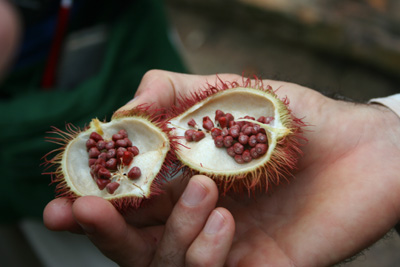 |
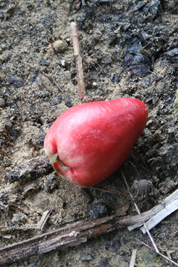 |
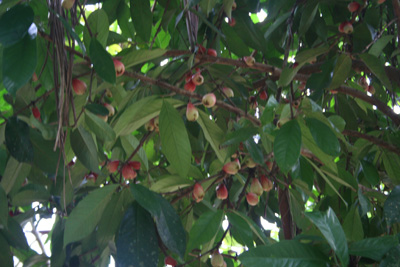 |
Above left is achiote (Bixa orellana) which was littering the ground around its small bush. The tree is best known as the source of annatto, a natural orange-red condiment. The ground seeds are widely used in traditional dishes throughout tropical America, presumably as much for its color as for its flavor. To that end annatto is an industrial food coloring adding yellow or orange color to many products such as butter, cheese, sausages, cakes, and popcorn. Achiote has long been used by American Indians to make a bright red paint for the body, hair and lipstick. For this reason, the achiote is sometimes called the lipstick tree. Barb applied the lipstick. It worked.
I would not have bothered to mention the tucumã fruit in the middle picture, and on the right, growing in its low tree, if it were not for the fact that a couple of days later this was the flavor of dinner's ice-cream.
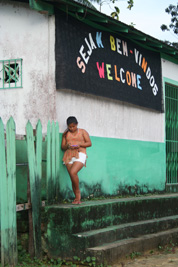
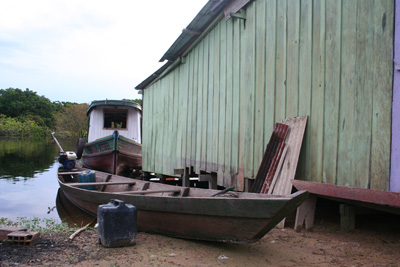
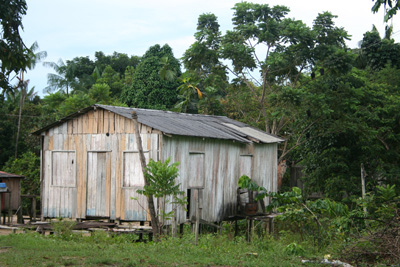
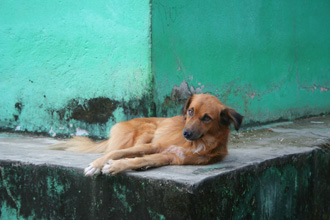 |
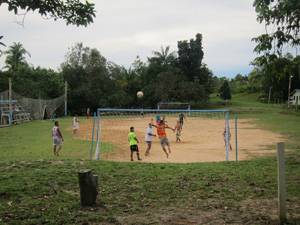 |
As we watched a soccer match in full swing, we learned of the intense team rivalries between settler villages, and of the multiday annual celebrations on the village’s Saint’s Day. I was reminded of a remark someone recently made to one of our children about my scattered and politically complicated family: “Your family is career oriented. Mine is family oriented.” Here, to his point, was a collection of people who clearly understood this distinction, and had chosen family. Of course we only had the briefest of snapshots, but in both communities we visited, the sense of community was palpable. Everybody seemed healthy, and as far as one could tell, they seemed content. |
In poignant contrast, the one person who seemed isolated, lost in their own private world, was a young woman studying the only cell phone we saw on the whole trip. Adam and I wondered to ourselves how it could be working, and who she might be calling that was not within shouting distance.
I had noticed a similar thing in Ghana. These folks who seemed so obviously poor on the outsid, seemed so rich on the inside. I asked Souza about one of the biggest differences I noticed: “Every village we visited in Ghana had someone who brewed the local moonshine. Neither of these villages seem to have a still. How come?” They definitely drink, because I spotted more than one empty vodka bottle lying around. “They don’t know how.” Perhaps one of the disadvantages of settling—returning—over being native, is having the history and tradition. Certainly the actual natives in Brazil are very skilled in creating the drugs of their choice from the materials available. But this was another indicator, along with the gas-powered equipment, of a dependency on the outside world and a need for commercial activity to generate buying power. An interesting balance.
Manioc is an important, not to say vital crop that we were shown growing in a field and spent some time discussing. Next stop was the hut where the settlers processed the harvest. The manioc is ground to a pulp with a small gas-powered mill. This masa is then squeezed in a press to dry it out. The liquid that drains contains the toxins. The pungent cheesy aroma of the squeezed but still draining masa filled the village. Already shredded, washed and squeezed (dogs have to be kept from drinking the drainage water because it will kill them), it sat in an open box about 6 feet by 3 feet by 1 foot tall, waiting to be baked in huge open pans. As we watched a couple of the villagers re-seal the ovens under the pans, Souza explained the process, and it was during this tale that he made the so-controversial observation “manioc is also known as tapioca.” There were audible scoffs of disbelief. The tale is too long to tell here but is chronicled on its own page.
|
|
|
The most obvious influence of the government was that although the villages only comprised a dozen or two homes, they both had schools, and the teachers were government employees. In both villages we met the teachers. One was at home (right) and the other was at work (far right). They both had children, and the one on the far right was there with her husband, also a teacher. In a curious story we never did seem to get to the bottom of, the child in the picture was number five or six. We were told that her husband (one of the villagers) was in his early twenties. Clearly this does not compute. Our most logical (but wholely unsubstantiated) theory was that he was the younger brother of her first husband and something happened to the brother. In some societies we know younger brothers become responsible for the widow and her children. |
 |
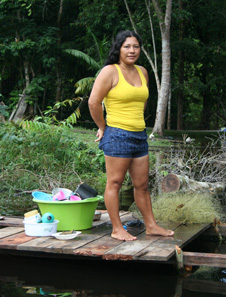 |
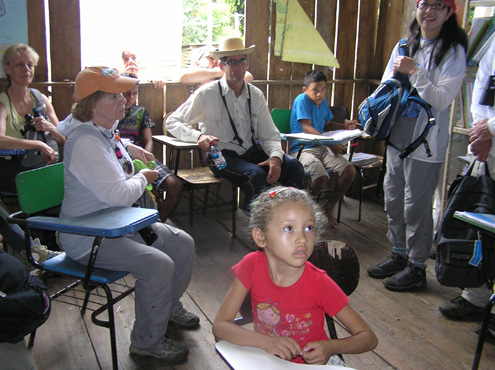
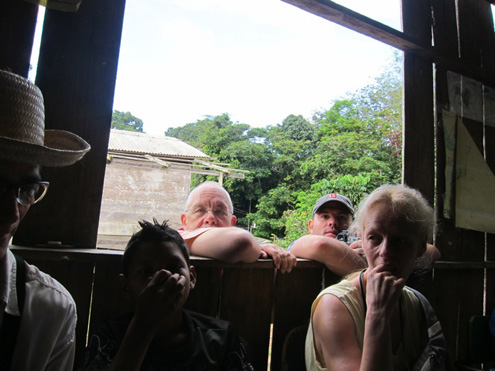
Image courtesy and © Lucy Mueller 2015 Image courtesy and © Mary Clements 2015
School was actually in session in one of the villages, and we were invited to interrupt the class. The two things they wanted to know, like any elementary school kid, was “how old are you?” and for Tamao “where are you from?” (aka “why do you look different from the rest of these white people?”). To her eternal credit, she was able to answer in Portuguese that although she was an American, her parents came from Japan. The five year olds knew the name of the American president, though most of us hadn’t a clue who their president was. They could point out the US on the world map that was pinned on the wall, (sent to them by a previous Tucano guest). When Adam said he was from London, I was amazed to notice that Edi could not point to England, let alone London. Later I asked him if he’d ever seen a picture of the Sydney Opera House (one of the most photographed buildings in the world) and he said no. It made me very conscious of how European/white my historical and cultural knowledge was, despite all the privileges of education and curiosity with which I have been so generously bestowed. Yes, at six years old I could point out Brazil and the Amazon on a map, but basically I’d added nothing to this knowledge-base since. I found the privilege of meeting these young people extremely moving. It would have had a profound effect on me as a child. I vividly remember the teacher from New Zealand and the visiting Australian rugby team (which soundly kicked our collective derriere). If this was a way to strengthen the bond between the ecotourist and the people in the places they visit, and perhaps more importantly the bond between those people to the ecotourist and the possible value they can supply, then bring it on. Peace on earth.
